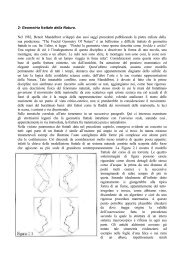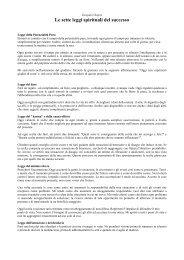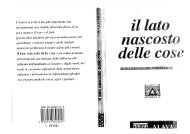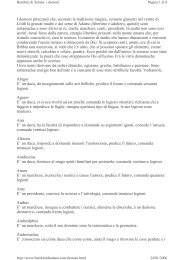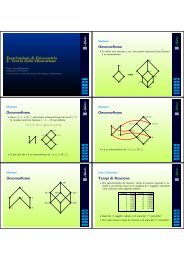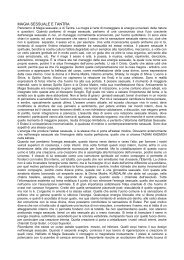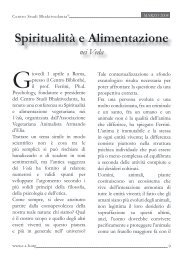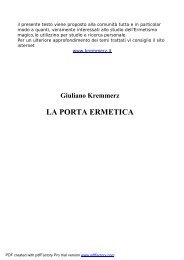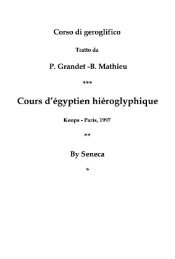GLOBAL JIHAD: THE ARAB-AFGHANS AND OSAMA BIN LADEN ~ 12910GLOBAL JIHAD:THE ARAB-AFGHANSAND OSAMA BIN LADENATorkham - the border post at the head of the Khyber Passbetween Afghanistan and Pakistan, a single chain banner.seperates the two countries. On the Pakistani side stand thesmartly turned out Frontier Scouts - paramilitaries in their grey shalwarkameezes and turbans. It was April 1989, and the Soviet withdrawal fromAfghanistan had just been completed. I was returning to Pakistan by roadfrom Kabul, but the barrier was closed. Exhausted from my journey I laydown on a grass verge on the Afghan side of the border and waited.Suddenly, along the road behind me, a truck full of Mujaheddin roaredup and stopped. But those on board were not Afghans. Light-colouredArabs, blue-eyed Central Asians and swarthy Chinese-looking facespeered out from roughly wound turbans and ill-fitting shalwar kameezes.They were swathed in ammunition belts and carried kalashnikovs. Exceptfor one Afghan, who was acting as interpreter and guide, not a single oneof the 30 foreigners spoke Pushto, Dari or even Urdu. As we waited forthe border to open we got talking.The group was made up of Filipino Moros, Uzbeks from Soviet CentralAsia, Arabs from Algeria, Egypt, Saudi Arabia and Kuwait and Uighursfrom Xinjiang in China. Their escort was a member of Gulbuddin Hikmetyar'sHizb-e-Islami. Under training at a camp near the border they weregoing on weekend leave to Peshawar and were looking forward to gettingmail from home, changing their clothes and having a good meal. Theyhad come to fight the jihad with the Mujaheddin and to train in weapons,bomb-making and military tactics so they could take the jihad back home.That evening, Prime Minister Benazir Bhutto had hosted a dinner forjournalists in Islamabad. Among the guests was Lieutenant GeneralHameed Gul, the head of the ISI and the most fervent Islamic ideologuein the army after Zia's death. General Gul was triumphant about theSoviet withdrawal. I asked him if he was not playing with fire by invitingMuslim radicals from Islamic countries, who were ostensibly allies of Pakistan.Would these radicals not create dissension in their own countries,endangering Pakistan's foreign policy? 'We are fighting a jihad and this isthe first Islamic international brigade in the modern era. The communistshave their international brigades, the West has NATO, why can't theMuslims unite and form a common front?' the General replied. It was thefirst and only justification I was ever given for what were already calledthe Arab-Afghans, even though none were Afghans and many were notArabs.Three years earlier in 1986, CIA chief William Casey had stepped upthe war against the Soviet Union by taking three significant, but at thattime highly secret, measures. He had persuaded the US Congress to providethe Mujaheddin with American-made Stinger anti-aircraft missilesto shoot down Soviet planes and provide US advisers to train the guerrillas.Until then no US-made weapons or personnel had been used directlyin the war effort. The CIA, Britain's MI6 and the ISI also agreedon a provocative plan to launch guerrilla attacks into the Soviet SocialistRepublics of Tajikistan and Uzbekistan, the soft Muslim underbelly of theSoviet state from where Soviet troops in Afghanistan received their supplies.The task was given to the ISI's favourite Mujaheddin leader GulbuddinHikmetyar. In March 1987, small units crossed the Amu Darya riverfrom bases in northern Afghanistan and launched their first rocket attacksagainst villages in Tajikistan. Casey was delighted with the news and onhis next secret trip to Pakistan he crossed the border into Afghanistanwith President Zia to review the Mujaheddin groups. 1Thirdly, Casey committed CLA support to a long-standing ISI initiativeto recruit radical Muslims from around the world to come to Pakistan andfight with the Afghan Mujaheddin. The ISI had encouraged this since1982 and by now all the other players had their reasons for supportingthe idea. President Zia aimed to cement Islamic unity, turn Pakistan intothe leader of the Muslim world and foster an Islamic opposition in CentralAsia. Washington wanted to demonstrate that the entire Muslim worldwas fighting the Soviet Union alongside the Afghans and their Americanbenefactors. And the Saudis saw an opportunity both to promote Wahabbismand get rid of its disgruntled radicals. None of the players reckonedon these volunteers having their own agendas, which would eventuallyturn their hatred against the Soviets on their own regimes and the Americans.Pakistan already had standing instructions to all its embassies abroadto give visas, with no questions asked, to anyone wanting to come and
130 ~ TALIBANfight with the Mujaheddin. In the Middle East, the Muslim Brotherhood,the Saudi-based World Muslim League and Palestinian Islamic radicalsorganized the recruits and put them into contact with the Pakistanis. TheISI and Pakistan's Jamaat-e-Islami set up reception committees to welcome,house and train the arriving militants and then encouraged themto join the Mujaheddin groups, usually the Hizb-e-Islami. The funds forthis enterprise came directly from Saudi Intelligence. French scholar OlivierRoy describes it as 'a joint venture between the Saudis, the MuslimBrotherhood and the Jamaat-e-Islami, put together by the ISI'. 2Between 1982 and 1992 some 35,000 Muslim radicals from 43 Islamiccountries in the Middle East, North and East Africa, Central Asia andthe Far East would pass their baptism under fire with the AfghanMujaheddin. Tens of thousands more foreign Muslim radicals came tostudy in the hundreds of new madrassas that Zia's military governmentbegan to fund in Pakistan and along the Afghan border. Eventually morethan 100,000 Muslim radicals were to have direct contact with Pakistanand Afghanistan and be influenced by the jihad.In camps near Peshawar and in Afghanistan, these radicals met eachother for the first time and studied, trained and fought together. It wasthe first opportunity for most of them to leam about Islamic movementsin other countries and they forged tactical and ideological links thatwould serve them well in the future. The camps became virtual universitiesfor future Islamic radicalism. None of the intelligence agenciesinvolved wanted to consider the consequences of bringing together thousandsof Islamic radicals from all over the world. 'What was more importantin the world view of history? The Taliban or the fall of the SovietEmpire? A few stirred-up Muslims or the liberation of Central Europe andthe end of the Cold War?' said Zbigniew Brzezinski, a former US NationalSecurity Adviser. 3 American citizens only woke up to the consequenceswhen Afghanistan-trained Islamic militants blew up the World TradeCentre in New York in 1993, killing six people and injuring 1,000.'The war,' wrote Samuel Huntington, 'left behind an uneasy coaliticof Islamist organizations intent on promoting Islam against all non-Muslim forces. It also left a legacy of expert and experienced fighters,training camps and logistical facilities, elaborate trans-Islam networks ipersonal and organization relationships, a substantial amount of militaryequipment including 300 to 500 unaccounted-for Stinger missiles, and,most important, a heady sense of power and self-confidence over whhad been achieved and a driving desire to move on to other victories.' 4Most of these radicals speculated that if the Afghan jihad had defeatedone superpower, the Soviet Union, could they not also defeat the othersuperpower, the US and their own regimes? The logic of this argumentwas based on the simple premise that the Afghan jihad alone had broughtGLOBAL JIHAD: THE ARAB-AFGHANS AND OSAMA BIN LADEN ~ 131the Soviet state to its knees. The multiple internal reasons which led tothe collapse of the Soviet system, of which the jihad was only one, wereconveniently ignored. So while the USA saw the collapse of the Sovietstate as the failure of the communist system, many Muslims saw it solelyas a victory for Islam. For militants this belief was inspiring and deeplyevocative of the Muslim sweep across the world in the seventh andeighth centuries. A new Islamic Ummah, they argued, could be forged bythe sacrifices and blood of a new generation of martyrs and more suchvictories.Amongst these thousands of foreign recruits was a young Saudi studentOsama Bin Laden, the son of a Yemeni construction magnate MohammedBin Laden who was a close friend of the late King Faisal and whosecompany had become fabulously wealthy on the contracts to renovateand expand the Holy Mosques of Mecca and Medina. The ISI had longwanted Prince Turki Bin Faisal, the head of htakhbarat, the Saudi IntelligenceService, to provide a Royal Prince to lead the Saudi contingent inorder to show Muslims the commitment of the Royal Family to the jihad.Only poorer Saudis, students, taxi-drivers and Bedouin tribesmen had sofar arrived to fight. But no pampered Saudi Prince was ready to rough itout in the Afghan mountains. Bin Laden, although not a royal, was closeenough to the royals and certainly wealthy enough to lead the Saudicontingent. Bin Laden, Prince Turki and General Gul were to becomefirm friends and allies in a common cause.The centre for the Arab-Afghans was the offices of the World MuslimLeague and the Muslim Brotherhood in Peshawar which was run byAbdullah Azam, a Jordanian Palestinian whom Bin Laden had first metat university in Jeddah and revered as his leader. Azam and his two sonswere assassinated by a bomb blast in Peshawar in 1989. During the 1980sAzam had forged close links with Hikmetyar and Abdul Rasul Sayyaf, theAfghan Islamic scholar, whom the Saudis had sent to Peshawar to promoteWahabbism. Saudi funds flowed to Azam and the Makhtab al Khidmator Services Centre which he created in 1984 to service the newrecruits and receive donations from Islamic charities. Donations fromSaudi Intelligence, the Saudi Red Crescent, the World Muslim Leagueand private donations from Saudi princes and mosques were channelledthrough the Makhtab. A decade later the Makhtab would emerge at thecentre of a web of radical organizations that helped carry out the WorldTrade Centre bombing and the bombings of US Embassies in Africa in1998.Until he arrived in Afghanistan, Bin Laden's life had hardly beenmarked by anything extraordinary. He was bom around 1957, the 17thof 57 children sired by his Yemeni father and a Saudi mother, one ofMohammed Bin Laden's many wives. Bin Laden studied for a Masters
- Page 1 and 2:
YALE NOTA BENE"The broader storyher
- Page 3 and 4:
TalibanMilitant Islam,Oil and Funda
- Page 5 and 6:
Vi ~ CONTENTSChapter 8A Vanished Ge
- Page 7 and 8:
AFGHANISTAN•^ UZBEKISTAN J TAJIKI
- Page 9 and 10:
2 ~ TALIBANaccounts for some 40 per
- Page 11 and 12:
"6 ~ TALIBANgas riches of landlocke
- Page 13 and 14:
10 ~ TALIBANgious mix that was to m
- Page 15 and 16:
Part 1History of theTaliban Movemen
- Page 17 and 18:
18 ~ ISLAM OIL AND THE NEW GREAT GA
- Page 19 and 20:
22 ~ ISLAM OIL AND THE NEW GREAT GA
- Page 21 and 22: 26 ~ ISLAM OIL AND THE NEW GREAT GA
- Page 23 and 24: 30 ~ ISLAM OIL AND THE NEW GREAT GA
- Page 25 and 26: 34 TALIBANKabul- Hikmetyar had alli
- Page 27 and 28: 38 ~ TALIBANrHERAT 1995: GOD'S INVI
- Page 29 and 30: 42 ~ TALIBANdo manage to take Kabul
- Page 31 and 32: J46 ~ TALIBANgreater weight to UN e
- Page 33 and 34: 50 ~ TALIBANas they hung from steel
- Page 35 and 36: 54 ~ TALIBANthey would help rearm t
- Page 37 and 38: 58 TALIBANGul Mohammed Pahlawan, Gh
- Page 39 and 40: 62 TALIBAN2,500 Taliban, who had re
- Page 41 and 42: 66 TALIBANshould throw all aid agen
- Page 43 and 44: 70 ~ TALIBANyears of battle and hel
- Page 45 and 46: 74 ~ TALIBANThousands of Hazaras we
- Page 47 and 48: 78 TALIBANhas become a plague,' sai
- Page 49 and 50: NEW STYLE FUNDAMENTALISM OF THE TAL
- Page 51 and 52: 86 TALIBANsity students - Hikmetyar
- Page 53 and 54: 90 TALIBANSharia was heavily influe
- Page 55 and 56: 94 TALIBANinflamed the debate in th
- Page 57 and 58: 98 TALIBANizing factor of Islam, it
- Page 59 and 60: 102 TALIBANadministrations made the
- Page 61 and 62: 106 ~ TAUBANfrom working, but it no
- Page 63 and 64: TALIBANUniversity, she held down a
- Page 65 and 66: 114 TALIBAN A VANISHED GENDER 115Ta
- Page 67 and 68: 118 TALIBANUS$1,300 - a small fortu
- Page 69 and 70: 122 TALIBANper cent of the total Pa
- Page 71: 126 TALIBANequipment, no electricit
- Page 75 and 76: 134TALIBANAugust 1996 noted that Bi
- Page 77 and 78: 138 ~ TALIBANwho were using the Kho
- Page 79 and 80: 11DICTATORS AND OILBARONS: THE TALI
- Page 81 and 82: 146 TALIBAN DICTATORS AND OIL BARON
- Page 83 and 84: 150 — TALIBANgrowth of beards and
- Page 85 and 86: 154TALIBAN1998 when international o
- Page 87 and 88: 158 ~ TALIBANaround Afghanistan? Af
- Page 89 and 90: 162 TALIBAN ROMANCING THE TALIBAN 1
- Page 91 and 92: 166 TALIBAN ROMANCING THE TALIBAN 1
- Page 93 and 94: ROMANCING THE TALIBAN 2: 1997-99 17
- Page 95 and 96: 174 — TALIBANnon-Russian pipeline
- Page 97 and 98: 178 — TALIBANROMANCING THE TALIBA
- Page 99 and 100: 182 ~ TALIBANApril 1999. 'The US ha
- Page 101 and 102: 186 ~ TALIBANters or the transport
- Page 103 and 104: 190 ~ TALIBANThis Wild West of free
- Page 105 and 106: 194 ~ TALIBANgovernance. Pakistani
- Page 107 and 108: 198 TALIBAN SHIA VERSUS SUNNI: IRAN
- Page 109 and 110: 202 TALIBAN SHIA VERSUS SUNNI: IRAN
- Page 111 and 112: 206 — TALIBANin Afghanistan - to
- Page 113 and 114: 210 — TALIBANand antagonism. The
- Page 115 and 116: 214 ~ TALIBANdrawn since 1996 - a P
- Page 117 and 118: 218 ~ TALIBANated and severely puni
- Page 119 and 120: Origins of Members of the Taliban M
- Page 121 and 122: APPENDIX 3 ~ 227Appendix 3A CHRONOL
- Page 123 and 124:
230 ~ TALIBANgraves near Shebarghan
- Page 125 and 126:
234 ~ TALIBAN8 June. US FBI places
- Page 127 and 128:
238 ~ TALIBAN1995 January16 MarchAp
- Page 129 and 130:
242 ~ TALIBANJune21 August10 Septem
- Page 131 and 132:
246 ~ TALIBANDupree, Nancy Hatch, A
- Page 133 and 134:
250 ~ NOTESChapter 31 Interview wit
- Page 135 and 136:
254 ~ NOTESmuddin, Religious Police
- Page 137 and 138:
258 NOTES13. The Japanese company M
- Page 139 and 140:
262 ~ NOTES28. Waxman, Sharon, 'A c
- Page 141 and 142:
Abbas, Mulla Mohammed 22,61,100Abda
- Page 143 and 144:
INDEX - 270Hazaras (continued)burea
- Page 145 and 146:
INDEX ~ 274nF»r\/FaliViar» milita
- Page 147:
INDEX ~ 278Talibans (continued)Sunn




